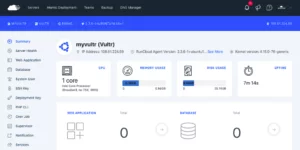In today’s rapidly evolving digital landscape, where speed and efficiency are paramount, the performance of websites and applications plays a critical role in providing a seamless user experience. When users visit a website or use an application, they expect it to load quickly and respond promptly to their actions. Slow loading times, unresponsive interfaces, and sluggish performance can be frustrating, leading to high bounce rates, dissatisfied users, and missed business opportunities.
To overcome these challenges, it is essential to optimize the performance of your server infrastructure. By fine-tuning your server configuration, leveraging advanced technologies, and adopting best practices, you can significantly enhance the speed and efficiency of your applications. This is where Vultr, a leading cloud infrastructure provider, comes in.
Vultr offers a powerful platform for hosting and deploying applications, providing developers and businesses with the tools they need to optimize performance. With Vultr, you have access to a wide range of server options, each designed to meet specific requirements such as CPU, RAM, storage, and server location. This allows you to select the most suitable server type that aligns with your application’s needs.
Factors Contributing to Vultr Success:

- Infrastructure Efficiency: Vultr has implemented an efficient infrastructure that offers reliable and high-performance cloud services. The global network of data centers, powered by high-speed SSD storage and modern server hardware, provides for low latency and fast response times for users worldwide.
- Scalability: Vultr’s platform offers excellent scalability, facilitating users to scale their resources up or down based on their requirements. With flexible options for CPU, RAM, and storage, users can adapt their infrastructure to handle varying workloads effectively.
- Network Performance: Vultr’s network performance is impressive, with multiple Tier-1 network carriers and redundant connections. This arrangement ensures high availability and minimizes network congestion, offering fast and stable connectivity.
- Control Panel: Vultr’s user-friendly control panel gives a streamlined interface for managing cloud resources. It offers features as one-click deployment of applications and easy access to essential functions, making it accessible to both beginners and experienced users.
- Documentation and Support: Vultr offers comprehensive documentation, tutorials, and an active community forum, enabling users to troubleshoot issues and optimize performance effectively. Additionally, their customer support team is responsive and helpful, ensuring that users receive timely assistance when needed.
- Cost-Effectiveness: Vultr provides competitive pricing options for their cloud services, allowing users to maximize their infrastructure while keeping costs under control. Their transparent pricing model and pay-as-you-go billing ensure users only pay for the resources they use.
Best Practices for Vultr Performance Optimization:
1. Choosing the Right Vultr Server:
When it comes to optimizing performance on Vultr, one of the crucial steps is selecting the right server type that meets your specific requirements. Vultr offers a wide range of server options across various regions, allowing you to choose the one that aligns best with your application’s needs.
- To choose the appropriate server type, consider the following factors:
CPU: The Central Processing Unit (CPU) executes instructions and processing tasks. Depending on the application’s computational needs, you may need a server with a higher CPU performance. Vultr provides different CPU options, ranging from standard CPUs to high-frequency CPUs, allowing you to select the optimal one for your workload.
RAM: Random Access Memory (RAM) is imperative for running applications and storing temporary data. The amount of RAM you need depends on the volume and complexity of your application. Vultr offers various RAM options, allowing you to choose the right amount for your specific requirements.
Storage: Vultr offers different storage types, like high-speed SSD and cost-effective block storage. Select the suitable storage option based on your application’s needs for speed, capacity, and cost-effectiveness. Learn more here.
- Server Location: The geographical location of the server plays a major role in determining the latency between the app and its users. Vultr has multiple data centers across the globe, enabling you to deploy your server close to target audience. Choosing a server location that is geographically close to users helps decrease latency and improves overall performance.
By carefully considering factors such as CPU, RAM, storage, and server location, and leveraging Vultr’s diverse range of server options, you can choose the server type that best meets your performance needs. This ensures that your application runs optimally, delivering a seamless and responsive experience to your users.
2. Utilizing Vultr’s Global Network:

Vultr currently has data centers in multiple regions, including North America, Europe, Asia-Pacific, and Australia. By deploying your app in a data center geographically closer to your target audience, you can ensure that the network distance between the users and the server is bare minimum. To explore Vultr’s global network and identify the available data center locations, you can visit their Datacenter Locations page. Learn here.
3. Optimal Server Configuration:
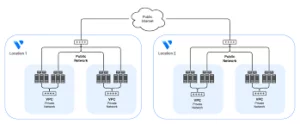
Optimizing your server configuration is imperatve to maximize performance on Vultr. By fine-tuning various settings for caching mechanisms, web server configurations, and database optimizations, you may significantly enhance response times and reduce server load. Implementing techniques like content caching, gzip compression, and query optimization will contribute to improved overall performance.
A. Caching Mechanisms: Implementing caching mechanisms can drastically enhance the performance of your applications. Caching involves storing frequently accessed data in memory, allowing for faster retrieval and reducing the need to fetch data from disk or execute complex computations repeatedly. Consider integrating these tools into your application architecture to cache data and improve response times.
- Redis: Redis is an in-memory data store that can be used as a cache or a database. It offers fast access to stored data, enabling quick retrieval and reducing the load on your primary database. You can learn more about Redis and its integration with Vultr on Redis.
- Memcached: Memcached is another popular caching system that stores data in memory for fast access. It is commonly used to cache database query results, session data, and other frequently accessed information. Vultr provides support for Memcached, and you can find more information on their website.
B. Web Server Configuration: Optimizing your web server configuration can significantly improve performance. Consider the following techniques:
- Gzip Compression: Enable gzip compression to reduce the size of data transferred between the server and client. This decreases bandwidth usage and affects response times. Most web servers, like Nginx and Apache, support gzip compression. Configure your web server to enable gzip compression and compress static and dynamic content before serving it to clients.
- HTTP/2: Consider using the HTTP/2 protocol, which offers improvements over its predecessor, HTTP/1.1. HTTP/2 allows for parallel requests, server push, and header compression, resulting in faster page loading and reduced latency. Ensure your web server and apps are compatible with HTTP/2 to take benefit.
C. Database Optimization: Optimizing your database can have a significant impact on performance. Consider the following techniques:
- Query Optimization: Analyze and optimize your database queries to minimize execution time. Ensure that indexes are properly set up, use appropriate join strategies, and avoid unnecessary queries. Optimizing your queries can significantly reduce database load and improve response times.
- Connection Pooling: Implement connection pooling to reuse database connections and avoid the overhead of establishing a new connection for each request. Connection pooling improves performance by minimizing connection setup time and reducing resource usage.
- Database Caching: Utilize database caching techniques to cache frequently accessed data and avoid querying the database for every request. Tools like Redis and Memcached can be used to cache database query results, reducing the load on the database server and improving response times.
4. Load Balancing for Scalability and Redundancy:
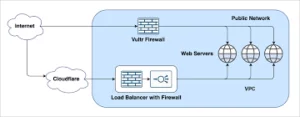
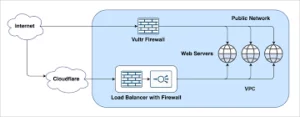
Vultr’s Load Balancer is a powerful tool for optimizing the performance and availability of your applications. It allows you to distribute incoming traffic across multiple servers, ensuring scalability and high availability. By configuring load balancing, you can evenly distribute requests and prevent overloading individual servers, leading to improved performance and a more reliable application. It offers flexible configuration options, allowing you to define how traffic is distributed. You can set up load balancing based on various algorithms, such as round-robin, least connections, or IP hash. These algorithms ensure that requests are evenly distributed among the available servers, improving performance and reducing response times.
Besides distributing traffic, Vultr’s Load Balancer service also provides high availability. If one server fails or becomes unreachable, the load balancer automatically routes traffic to the remaining healthy servers, ensuring that your application remains accessible and minimizing downtime. To configure load balancing on Vultr, you can visit the Load Balancers page on the Vultr website. From there, you can create and manage load balancers, define backend servers, set up health checks, and configure the load balancing algorithm according to your application’s needs.
5. Content Delivery Networks (CDNs):

Integrating Vultr with a Content Delivery Network (CDN) is an excellent strategy to enhance the performance of your website or application, especially for global audiences. CDNs are designed to cache and deliver static content, such as images, CSS files, and JavaScript libraries, from edge locations located closer to the end-users. This reduces latency, improves load times, and enhances the overall user experience.
Vultr is compatible with several popular CDNs, allowing you to leverage their robust network infrastructure and caching capabilities. By integrating Vultr with a CDN, you can take advantage of the following benefits:
- Reduced Latency: CDNs have a global network of edge locations strategically distributed around the world. When a user requests content from your website, the CDN serves the content from the edge location nearest to the user. This minimizes the physical distance between the user and the server, reducing latency and improving response times.
- Improved Load Times: With a CDN, static content is cached on edge servers, eliminating the need for the content to be fetched from the origin server for each request. This results in faster load times since the content is readily available at the edge locations. Users experience quicker page rendering and improved performance, leading to a positive browsing experience.
- Scalability and Reliability: CDNs are designed to handle high volumes of traffic and distribute it efficiently across their network. By offloading the delivery of static content to a CDN, you can alleviate the load on your origin server, improving its scalability and reliability. CDNs also provide additional features such as DDoS protection and automatic failover, enhancing the overall security and availability of your website. To integrate Vultr with a CDN, explore the compatibility options with popular CDNs like Nestify. These CDNs offer integration guides and documentation to help you configure and set up the integration efficiently.
6. Monitoring and Optimization:
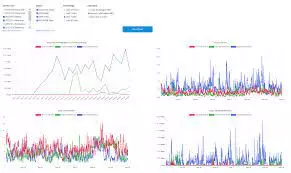
Regularly monitoring your Vultr instances is crucial for maintaining optimal performance and ensuring the smooth operation of your applications. By monitoring resource utilization, network performance, and application metrics, you can identify bottlenecks, detect issues, and make informed decisions to improve performance. Vultr provides built-in monitoring tools, and you can also leverage third-party monitoring services for comprehensive monitoring and analysis.
- Utilize Built-in Monitoring Tools: The Vultr Dashboard provides real-time data on CPU usage, memory consumption, disk I/O, and network traffic. You can access the monitoring data directly from the Vultr control panel to gain visibility into resource utilization and identify any potential issues.
- Third-Party Monitoring Services: Besides Vultr’s built-in tools, you can integrate third-party monitoring services for more advanced monitoring capabilities. Services like Datadog, New Relic, or Prometheus offer comprehensive monitoring solutions with customizable dashboards, alerting systems, and advanced analytics. These services allow you to monitor application-specific metrics, track performance trends, and set up proactive alerts for critical events.
- Resource Utilization: Monitor CPU, memory, and disk usage to ensure that your server has sufficient resources to handle the workload. High resource utilization can indicate performance bottlenecks or the need for resource scaling. Adjust resource allocations accordingly by upgrading CPU, adding more RAM, or increasing storage capacity to maintain optimal performance.
- Network Performance: Monitor network metrics such as latency, throughput, and packet loss to ensure smooth communication between your server and users. High network latency or packet loss can affect application responsiveness and user experience. Address network issues by optimizing network configurations, selecting the appropriate data center location, or working with your internet service provider (ISP) to improve connectivity.
- Application Metrics: Monitor application-specific metrics such as response times, request rates, and error rates. Analyzing these metrics helps you identify performance bottlenecks within your application code or database queries. Use tools like application performance monitoring (APM) services to gain deeper insights into your application’s behavior and pinpoint areas for optimization.
To get started with monitoring your Vultr instances, you can access the built-in monitoring tools from the Vultr Dashboard. Additionally, you can explore and integrate third-party monitoring services such as Datadog, , or Prometheus to enhance your monitoring capabilities and gain deeper insights into your server and application performance.
7. Implementing Content Caching:
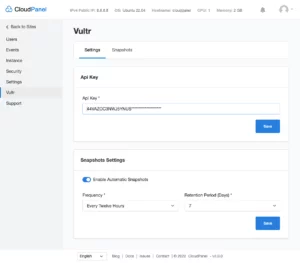
Implementing caching mechanisms is a valuable strategy to optimize the performance of your server and improve response times. By leveraging caching techniques such as browser caching, reverse proxies, and content delivery networks (CDNs), you can effectively reduce the load on your server and serve static content more efficiently.
Here are some caching mechanisms to consider:
- Browser Caching: By instructing web browsers to cache static files, such as images, CSS, and JavaScript, you can reduce the number of requests made to your server. When a user visits your website, their browser will check if it has a cached copy of the file and retrieve it locally instead of making a new request to the server. This minimizes server load and improves the overall loading speed for returning visitors. You can implement browser caching by setting appropriate caching headers or using cache-control directives in your server configuration.
- Reverse Proxies: Reverse proxies act as intermediaries between clients and your server. They can cache static content on their servers and serve it directly to clients, reducing the load on your origin server. Nginx and Varnish are popular reverse proxy servers that can be configured to cache and serve static files efficiently. By caching content at the reverse proxy level, you can improve response times and handle higher traffic volumes.
- Content Delivery Networks (CDNs): CDNs are geographically distributed networks of servers that cache and deliver static content from edge locations closer to the end-users. When a user requests a static file, the CDN serves it from the nearest edge server, reducing latency and improving load times.
To implement caching mechanisms, you can refer to the documentation and guides provided by the relevant technologies and services:
- Browser Caching: You can learn more about implementing browser caching by referring to the documentation specific to your web server. For example, Apache HTTP Server provides directives for caching static files, while Nginx offers configuration options for caching.
- Reverse Proxies: If you choose to use a reverse proxy server like Nginx or Varnish, you can explore their official documentation for detailed configuration instructions on caching static content. The Nginx documentation on caching and the Varnish documentation on caching can be valuable resources.
- Content Delivery Networks (CDNs): To leverage CDNs for caching static content, you can sign up for a CDN service provider such as Cloudflare or Nestify. These providers offer comprehensive documentation and guides to help you integrate their services with your server and configure caching effectively.
By utilizing caching mechanisms such as browser caching, reverse proxies, and CDNs, you can reduce the load on your server, improve response times, and enhance the overall performance of your website or application.
8. Regular Software Updates and Security:
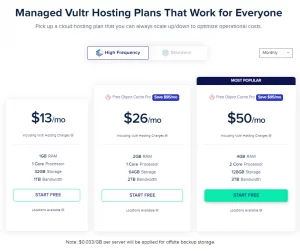
Keeping your Vultr server up-to-date with the latest software patches and security updates is crucial for maintaining optimal performance and ensuring the security of your applications and data. Regular updates help address vulnerabilities, improve performance, and introduce new features. Here are some key steps to follow:
- Operating System Updates: Regularly update your server’s operating system to benefit from bug fixes, performance improvements, and security patches. Vultr supports a wide range of operating systems, including popular choices like Ubuntu Documentation, , and Debian.
- Web Server Updates: If you are using a specific web server such as Apache or Nginx, ensure that you keep them updated to leverage the latest performance optimizations, bug fixes, and security patches.
- Application Updates: If you are running applications on your Vultr server, it is important to keep them updated as well. Most applications have their own update mechanisms or package managers to ensure you have the latest version. Visit the official websites or documentation of your applications for instructions on how to update them.
- Automation and Monitoring: Consider implementing automation and monitoring tools to streamline the update process and stay informed about available updates. Tools like Ansible, Chef, or Puppet can help automate the update process across multiple servers, while monitoring services like Nagios or Zabbix can alert you to outdated software versions and security vulnerabilities By regularly updating your operating system, web server, and applications, you can benefit from performance enhancements, bug fixes, and security patches. This ensures that your Vultr server is running the latest stable versions of software, minimizing the risk of performance issues and security vulnerabilities.
Conclusion:
Vultr is a reliable choice for individuals and businesses seeking high-performance cloud hosting solutions. With their robust cloud infrastructure, efficient infrastructure design, scalability options, strong network performance, user-friendly control panel, extensive documentation, and cost-effective pricing, Vultr offers a comprehensive package that meets the needs of a wide range of users.
Learn about the comparative study of different hosting providers here.
FAQs on Vultr:
Are there any other performance optimization techniques I should consider?
Yes, there are additional techniques you can employ, such as optimizing your database queries, minimizing external HTTP requests, optimizing images and media files, implementing lazy loading, and leveraging browser caching. Each optimization technique focuses on a specific aspect of your application to further enhance performance.
How can I improve the speed of my website hosted on Vultr?
Here are some tips to enhance the speed of your website:
- Optimize your images by compressing them and using appropriate formats.
- Leverage browser caching to store static resources locally.
- Enable GZIP compression to reduce file sizes transmitted over the network.
- Utilize a Content Delivery Network (CDN) to distribute your website’s content across multiple servers globally.
- Minify and combine CSS and JavaScript files to reduce the number of HTTP requests.
- Implement lazy loading for images and videos to defer their loading until they become visible.
- Utilize HTTP/2 to enable concurrent requests and reduce latency.
How can I monitor the performance of my Vultr server?
Vultr provides monitoring tools within the control panel to track resource usage, bandwidth, and server health. Additionally, you can use external monitoring services like New Relic, Datadog, or Prometheus to gain deeper insights into server performance and receive alerts for potential issues.
Does Vultr offer any additional services to optimize performance?
Vultr offers additional services such as Block Storage and Dedicated Cloud Compute that can provide additional resources and performance improvements for your server. Remember that optimizing performance is an ongoing process, and regularly reviewing and fine-tuning your configurations and code can lead to significant improvements.

